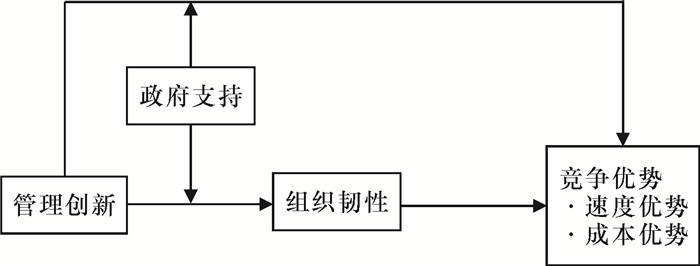How does Management Innovation Affect Enterprise Competitive Advantage?The Role of Organizational Resilience and Government Support under the Impact of the COVID-19 Pandemic
-
摘要: 新冠疫情事件的冲击给企业带来新的问题,即如何在重大危机事件下进行管理创新、增强组织韧性、获取竞争优势,以保障企业持续健康地发展。基于制度理论和动态能力理论,实证分析管理创新影响企业竞争优势的作用机制,结果发现:管理创新能够直接提升企业的竞争优势;管理创新能增强组织韧性,而组织韧性能给企业带来速度优势和成本优势,因此管理创新能通过增强组织韧性间接提升企业的竞争优势;政府支持能强化管理创新对组织韧性的正向影响作用,也能强化管理创新对成本优势的正向影响作用。Abstract: The impact of the COVID-19 pandemic brings new problems for enterprises that enterprises should carry out management innovation, enhance organizational resilience and gain competitive advantage in the event of major crisis to ensure the sustainable and healthy development.Based on the institutional theory and dynamic capability theory, this paper empirically analyzes the mechanism of management innovation affecting the competitive advantage of enterprises. The results show as follows. Firstly, management innovation can directly improve the competitive advantage of enterprises. Secondly, management innovation can increase the organizational resilience, and organizational resilience can bring speed advantage and cost advantage to enterprises. Therefore, management innovation can indirectly improve competitive advantage by increasing organizational resilience.Thirdly, the positive effect of management innovation on organizational resilience can be strengthened by government support, and the positive effect of management innovation on cost advantage can also be strengthened by government support.
-
表 1 样本企业基本情况
家, % 特征 类别 样本数 占比 企业年龄 1~9年 174 84.47 10~19年 27 13.11 20年以上 5 2.42 员工人数 小于20人 136 66.02 20~299人 68 33.01 300~999人 2 0.97 2019年营业收入 300万元以下 127 61.65 300万元以上2 000万元以下 63 30.58 2 000万元以上40 000万元以下 15 7.28 40 000万元以上 1 0.49 行业属性 信息传输、软件和信息技术服务业 96 46.6 科学研究和技术服务业 45 21.84 制造业 15 7.28 租赁和商务服务业 12 5.83 文化、体育和娱乐业 11 5.34 批发和零售业 9 4.37 其他 18 8.74 有无海外业务 有海外业务 17 8.25 无海外业务 189 91.75 表 2 变量及测量题项
变量 题项 因子载荷 组合信度 α值 管理创新 在疫情发生之前,公司会定期调整工作的规则与流程 0.713 0.857 0.864 在疫情发生之前,公司会定期调整员工的任务与职能 0.802 在疫情发生之前,公司会定期实施(采用)新的管理系统 0.848 在疫情发生之前,公司会定期调整薪酬政策 0.459 在疫情发生之前,公司会定期调整部门内及部门间的沟通方式 0.777 在疫情发生之前,公司会经常调整组织结构的某些元素 0.601 政府支持 疫情期间,政府及时出台了对公司有益的政策 0.793 0.937 0.935 疫情期间,政府及时帮助公司获取资源(资金、劳动力、关键基础原料等) 0.937 疫情期间,政府及时为公司提供生产要素(土地、设备、技术等)扶持 0.889 疫情期间,政府及时为公司提供了到位的服务(用工支持、配套服务等) 0.877 疫情期间,政府及时给予公司各类收费优惠(税收、行政/事业性收费等) 0.828 组织韧性 面对新冠疫情等重大突发事件,我所在的公司能够坚持并保持其地位 0.669 0.911 0.907 面对新冠疫情等重大突发事件,我所在的公司成功地提出了多种解决方法方案 0.667 面对新冠疫情等重大突发事件,我所在的公司为了不损失而一直在抵抗支撑着 0.510 面对新冠疫情等重大突发事件,我所在的公司不会放弃并坚持原有的(发展)路线 0.802 面对新冠疫情等重大突发事件,我所在的公司能够迅速采取行动 0.831 面对新冠疫情等重大突发事件,我所在的公司会为了从不利的环境中获益而研制替代方案 0.701 面对新冠疫情等重大突发事件,我所在的公司会灵活地在必要时采取所需的行动 0.869 面对新冠疫情等重大突发事件,我所在的公司仍然是一个所有员工都能各司其职的企业 0.685 面对新冠疫情等重大突发事件,我所在的公司仍然能够成功地把所有员工凝聚成一个整体来做事 0.791 速度优势 与主要竞争对手相比,公司总是能够率先采用新工艺、技术和方法 0.869 0.904 0.904 与主要竞争对手相比,公司总是能够率先推出新的产品和服务 0.836 与主要竞争对手相比,公司经常能够在行业内率先购买或掌握原创技术 0.908 成本优势 公司的单位产品开发成本低于主要竞争对手 0.942 0.921 0.920 公司的单位产品制造成本低于主要竞争对手 0.923 公司的单位产品销售成本低于主要竞争对手 0.841 公司的产品终端销售价格低于主要竞争对手 0.736 表 3 区分效度与共同方法偏差检验结果(N=206)
变量 χ2 df χ2/df RMR RMSEA CFI TLI IFI PCFI 五因子+共同方法因子模型 423.888 269 1.576 0.034 0.053 0.963 0.952 0.964 0.738 五因子模型 486.785 296 1.645 0.039 0.056 0.955 0.946 0.955 0.805 四因子模型 689.917 300 2.300 0.048 0.080 0.907 0.891 0.908 0.775 三因子模型 1197.921 306 3.915 0.102 0.119 0.787 0.756 0.790 0.686 二因子模型 1995.162 310 6.436 0.100 0.163 0.598 0.545 0.602 0.528 单因子模型 2425.025 314 7.723 0.109 0.181 0.497 0.438 0.501 0.444 注:五因子模型:管理创新、政府支持、组织韧性、速度优势、成本优势;四因子模型:管理创新、政府支持、组织韧性、速度优势+成本优势;三因子模型:政府支持、管理创新+组织韧性、速度优势+成本优势;二因子模型:政府支持、管理创新+组织韧性+速度优势+成本优势;单因子模型:管理创新+政府支持+组织韧性+速度优势+成本优势。 表 4 各核心变量的描述性统计与相关分析结果(N=206)
变量 1 2 3 4 5 管理创新 0.779 组织韧性 0.444*** 0.769 政府支持 0.311*** 0.495*** 0.891 速度优势 0.286*** 0.533*** 0.267*** 0.855 成本优势 0.298*** 0.386*** 0.296*** 0.685*** 0.830 均值 3.498 3.776 3.542 3.359 3.163 标准差 0.725 0.610 0.771 0.809 0.768 注:***代表P < 0.001;表中划线数字为各潜变量的AVE平方根。 表 5 管理创新、政府支持、组织韧性与竞争优势的回归结果(N=206)
变量 组织韧性 速度优势 成本优势 M1 M2 M3 M4 M5 M6 M7 M8 常量 2.123 1.423 1.198 1.198 0.241 1.052 1.047 0.650 企业年龄 0.069 0.058 0.170* 0.170* 0.141+ 0.148+ 0.149+ 0.136+ 员工人数 0.073 0.139* 0.086 0.087 0.016 0.045 0.053 0.022 营业收入 0.055 -0.031 -0.015 -0.015 0.001 0.028 0.024 0.031 制造业 0.114 0.070 0.151+ 0.151+ 0.115 0.145+ 0.141+ 0.126 有无海外业务 -0.060 -0.090 -0.024 -0.026 0.020 -0.101 -0.117+ -0.097 管理创新 0.451*** 0.311*** 0.219** 0.218** 0.061 0.233*** 0.223** 0.154* 政府支持 0.405*** 0.195** 0.195** -0.010 0.220** 0.222** 0.132+ 管理创新×政府支持 0.126* 0.010 -0.054 0.130* 0.102 组织韧性 0.507*** 0.221*** Adj. R2 0.195 0.348 0.114 0.110 0.273 0.135 0.147 0.175 ΔR2 0.197 0.016 0.033 0.000 0.161 0.042 0.016 0.031 F 9.282*** 14.706*** 4.766*** 4.152*** 9.563*** 5.556*** 5.429*** 5.835*** 注:***代表P < 0.001;**代表P < 0.010;*代表P < 0.050;+代表P < 0.100。 -
[1] BIRKINSHAW J, HAMEL G, MOL M J. Management innovation[J]. Academy of Management Review, 2008, 33(4): 825-845. doi: 10.5465/amr.2008.34421969 [2] HAMEL G. The why, what, and how of management innovation[J]. Harvard Business Review, 2006, 84(2): 72-84, 163. http://www.ncbi.nlm.nih.gov/pubmed/16485806 [3] ALGHANMI A O. Innovations as the competitive advantage for small and medium enterprises: the case for the Kingdom of Saudi Arabia[J]. Marketing and Management of Innovations, 2020, 2: 196-205. http://www.researchgate.net/publication/343200747_Innovations_as_the_Competitive_Advantage_for_Small_and_Medium_Enterprises_the_Case_for_the_Kingdom_of_Saudi_Arabia [4] CHATZOGLOU P, CHATZOUDES D. The role of innovation in building competitive advantages: an empirical investigation[J]. European Journal of Innovation Management, 2018, 21(1): 44-69. doi: 10.1108/EJIM-02-2017-0015 [5] ANNING-DORSON T. Innovation and competitive advantage creation: the role of organisational leadership in service firms from emerging markets[J]. International Marketing Review, 2018, 35(4): 580-600. doi: 10.1108/IMR-11-2015-0262 [6] EIDIZADEH R, SALEHZADEH R, ESFAHANI A C. Analysing the role of business intelligence, knowledge sharing and organisational innovation on gaining competitive advantage[J]. Journal of Workplace Learning, 2017, 29(4): 250-267. doi: 10.1108/JWL-07-2016-0070 [7] MULYONO, MANURUNG A H, ALAMSJAH F, et al. The effect of corporate governance, e-business and innovation on competitive advantage and implication on financial performance[J]. Social Sciences & Humanities, 2020, 28(S1): 1-13. http://www.researchgate.net/publication/342048510_SOCIAL_SCIENCES_HUMANITIES_The_Effect_of_Corporate_Governance_E-Business_and_Innovation_on_Competitive_Advantage_and_Implication_on_Financial_Performance [8] CAMISÓN C, VILLAR-LÓPEZ A. Non-technical innovation: organizational memory and learning capabilities as antecedent factors with effects on sustained competitive advantage[J]. Industrial Marketing Management, 2011, 40(8): 1294-1304. doi: 10.1016/j.indmarman.2011.10.001 [9] MAHMOOD A, ARSLAN A. Ahead of the curve: leveraging antecedents of corporate entrepreneurship to pull off competitive advantage[J]. Frontiers in Psychology, 2020, 11: 1-16. doi: 10.3389/fpsyg.2020.00001 [10] KNOP K. Importance of visual management in metal and automotive branch and its influence in building a competitive advantage[J]. Polish Journal of Management Studies, 2020, 22(1): 263-278. doi: 10.17512/pjms.2020.22.1.17 [11] 沈灏, 魏泽龙. 不同创新组合情境下的组织学习与竞争优势[J]. 经济管理, 2013(3): 54-63. https://www.cnki.com.cn/Article/CJFDTOTAL-JJGU201303010.htm [12] HEIJ C V, VOLBERDA H W, VAN DEN BOSCH F A J, et al. How to leverage the impact of R & D on product innovation? the moderating effect of management innovation[J]. R & D Management, 2020, 50(2): 277-294. doi: 10.1111/radm.12396 [13] LIAO J W, KICKUL J R, MA H. Organizational dynamic capability and innovation: an empirical examination of internet firms[J]. Journal of Small Business Management, 2009, 47(3): 263-286. doi: 10.1111/j.1540-627X.2009.00271.x [14] SONG Y G, WU Y G, DENG G Y, et al. Intermediate imports, institutional environment, and export product quality upgrading: evidence from Chinese micro-level enterprises[J]. Emerging Markets Finance and Trade, 2021, 57(2): 400-426. doi: 10.1080/1540496X.2019.1668765 [15] 毛其淋, 许家云. 中间品贸易自由化、制度环境与生产率演化[J]. 世界经济, 2015(9): 80-106. https://www.cnki.com.cn/Article/CJFDTOTAL-SJJJ201509005.htm [16] BUSTINZA O F, VENDRELL-HERRERO F, PEREZ-AROSTEGUI M, et al. Technological capabilities, resilience capabilities and organizational effectiveness[J]. The International Journal of Human Resource Management, 2019, 30(8): 1370-1392. doi: 10.1080/09585192.2016.1216878 [17] BOUAZIZ F, HACHICHA Z S. Strategic human resource management practices and organizational resilience[J]. Journal of Management Development, 2018, 37(7): 537-551. doi: 10.1108/JMD-11-2017-0358 [18] CHOWDHURY M, PRAYAG G, ORCHISTON C, et al. Postdisaster social capital, adaptive resilience and business performance of tourism organizations in Christchurch, New Zealand[J]. Journal of Travel Research, 2019, 58(7): 1209-1226. doi: 10.1177/0047287518794319 [19] 张公一, 张畅, 刘晚晴. 化危为安: 组织韧性研究述评与展望[J]. 经济管理, 2020(10): 192-208. https://www.cnki.com.cn/Article/CJFDTOTAL-JJGU202010011.htm [20] STALK G. Time-the next source of competitive advantage[J]. Harvard Business Review, 1988, 66(4): 41-51. http://gateway.proquest.com/openurl?res_dat=xri:pqm&ctx_ver=Z39.88-2004&rfr_id=info:xri/sid:baidu&rft_val_fmt=info:ofi/fmt:kev:mtx:article&genre=article&jtitle=Harvard%20Business%20Review&atitle=Time--The%20Next%20Source%20of%20Competitive%20Advantage [21] PORTER M E. 竞争战略[M]. 陈小悦, 译. 北京: 华夏出版社, 1997: 34. [22] WALKER R M, DAMANPOUR F, DEVECE C A. Management innovation and organizational performance: the mediating effect of performance management[J]. Journal of Public Administration Research and Theory, 2011, 21(2): 367-386. doi: 10.1093/jopart/muq043 [23] FRISHAMMAR J, KURKKIO M, ABRAHAMSSON L, et al. Antecedents and consequences of firms' process innovation capability: a literature review and a conceptual framework[J]. IEEE Transactions on Engineering Management, 2012, 59(4): 519-529. doi: 10.1109/TEM.2012.2187660 [24] 朱瑜, 王雁飞, 蓝海林. 组织学习、组织创新与企业核心能力关系研究[J]. 科学学研究, 2007(3): 536-540. doi: 10.3969/j.issn.1003-2053.2007.03.026 [25] 林海芬, 苏敬勤. 战略性管理创新纵向传递机制研究——基于意义建构和意义给赋视角[J]. 管理学报, 2014(10): 1491-1498. doi: 10.3969/j.issn.1672-884x.2014.10.011 [26] 张秀娥, 滕欣宇. 组织韧性内涵、维度及测量[J]. 科技进步与对策, 2021(10): 9-17. doi: 10.6049/kjjbydc.2020090049 [27] LE BAS C, MOTHE C, NGUYEN-THI T U. The differentiated impacts of organizational innovation practices on technological innovation persistence[J]. European Journal of Innovation Management, 2015, 18(1): 110-127. doi: 10.1108/EJIM-09-2012-0085 [28] 张振刚, 姚聪, 余传鹏. 管理创新实施对中小企业成长的"双刃剑"作用[J]. 科学学研究, 2018(7): 1325-1333. doi: 10.3969/j.issn.1003-2053.2018.07.019 [29] ZHANG Y G, KHAN U, LEE S, et al. The influence of management innovation and technological innovation on organization performance: a mediating role of sustainability[J]. Sustainability, 2019, 11(2): 1-21. [30] KRAUS S, CLAUSS T, BREIER M, et al. The economics of COVID-19: initial empirical evidence on how family firms in five European countries cope with the corona crisis[J]. International Journal of Entrepreneurial Behavior & Research, 2020, 26(5): 1067-1092. doi: 10.1108/IJEBR-04-2020-0214 [31] MORALES S N, MARTINEZ L R, GOMEZ J A H, et al. Predictors of organizational resilience by factorial analysis[J]. International Journal of Engineering Business Management, 2019, 11: 1-13. http://www.onacademic.com/detail/journal_1000042308848599_fc0e.html [32] 汤敏, 李仕明, 刘斌. 突发灾害背景下组织韧性及其演化——东方汽轮机有限公司应对"5.12"汶川地震与恢复重建的案例研究[J]. 技术经济, 2019(1): 28-37. doi: 10.3969/j.issn.1002-980X.2019.01.004 [33] INGRAM T, BRATNICKA-MYSLIWIEC K. Organizational resilience of family businesses[J]. ProblemyZarzadzania-Management Issues, 2019, 17(2): 186-204. http://econpapers.repec.org/scripts/a/abstract.pf?p=y;h=RePEc:sgm:pzwzuw:v:17:i:82:y:2019:p:186-204 [34] DESJARDINE M, BANSAL P, YANG Y. Bouncing back: building resilience through social and environmental practices in the context of the 2008 global financial crisis[J]. Journal of Management, 2019, 45(4): 1434-1460. doi: 10.1177/0149206317708854 [35] MCCARTHY I P, COLLARD M, JOHNSON M. Adaptive organizational resilience: an evolutionary perspective[J]. Current Opinion in Environment Sustainability, 2017, 28: 33-40. doi: 10.1016/j.cosust.2017.07.005 [36] RAI S S, RAI S, SINGH N K. Organizational resilience and social-economic sustainability: COVID-19 perspective[J]. Environment Development and Sustainability, 2021, 23(8): 12006-12023. doi: 10.1007/s10668-020-01154-6 [37] TEIXEIRA E D O, WERTHER W B. Resilience: continuous renewal of competitive advantages[J]. Business Horizons, 2013, 56(3): 333-342. doi: 10.1016/j.bushor.2013.01.009 [38] WILLIAMS T A, GRUBER D A, SUTCLIFFE K M, et al. Organizational response to adversity: fusing crisis management and resilience research streams[J]. Academy of Management Annals, 2017, 11(2): 733-769. doi: 10.5465/annals.2015.0134 [39] GEBAUER H. Exploring the contribution of management innovation to the evolution of dynamic capabilities[J]. Industrial Marketing Management, 2011, 40(8): 1238-1250. doi: 10.1016/j.indmarman.2011.10.003 [40] 朱瑜, 王小霏, 孙楠, 等. 基于战略人力资源管理视角的组织复原力研究[J]. 管理评论, 2014(12): 78-90. https://www.cnki.com.cn/Article/CJFDTOTAL-ZWGD201412010.htm [41] 诸彦含, 赵玉兰, 周意勇, 等. 组织中的韧性: 基于心理路径和系统路径的保护性资源建构[J]. 心理科学进展, 2019(2): 357-369. https://www.cnki.com.cn/Article/CJFDTOTAL-XLXD201902016.htm [42] LUTHANS F, YOUSSEF C M. Emerging positive organizational behavior[J]. Journal of Management, 2007, 33(3): 321-349. doi: 10.1177/0149206307300814 [43] 涂智苹, 宋铁波. 制度理论在经济组织管理研究中的应用综述——基于Web of Science(1996-2015)的文献计量[J]. 经济管理, 2016(10): 184-199. doi: 10.3969/j.issn.1671-0975.2016.10.080 [44] 郑烨, 姬晴晴. 政府支持企业创新的国内外研究述评[J]. 经济体制改革, 2018(1): 175-182. https://www.cnki.com.cn/Article/CJFDTOTAL-JJTG201801027.htm [45] 岳文, 赵静燕. 异质性企业、政府补贴与技术升级[J]. 财经论丛, 2020(7): 3-12. https://www.cnki.com.cn/Article/CJFDTOTAL-CJLC202007001.htm [46] 韩晨, 高山行, 王钦. 政府支持提升企业财务绩效的机理——双核创新的多重中介效应[J]. 软科学, 2018(9): 34-38. https://www.cnki.com.cn/Article/CJFDTOTAL-XUXI201809008.htm [47] BAMGBADE J A, KAMARUDDEEN A M, NAWI M N M, et al. Does government support matter? influence of organizational culture on sustainable construction among malaysian contractors[J]. International Journal of Construction Management, 2018, 18(2): 93-107. doi: 10.1080/15623599.2016.1277057 [48] LIU T S, WANG J Y, ZHU Y, et al. Linking economic performance and sustainable operations of China's manufacturing firms: what role does the government involvement play[J]. Sustainable Cities and Society, 2021, 67: 1-12. [49] PENG M W, SUN S L, PINKHAM B, et al. The institution-based view as a third leg for a strategy tripod[J]. Academy of Management Perspectives, 2009, 23(3): 63-81. doi: 10.5465/amp.2009.43479264 [50] 许志端, 阮舟一龙. 营商环境、技术创新和企业绩效——基于我国省级层面的经验证据[J]. 厦门大学学报: 哲学社会科学版, 2019(5): 123-134. doi: 10.3969/j.issn.0438-0460.2019.05.012 [51] 李政, 杨思莹. 创新活动中的政府支持悖论: 理论分析与实证检验[J]. 经济科学, 2018(2): 88-100. https://www.cnki.com.cn/Article/CJFDTOTAL-JJKX201802008.htm [52] 李笑, 华桂宏, 李锦生. 政府支持、融资约束与企业对外直接投资[J]. 山西财经大学学报, 2019(5): 28-39. https://www.cnki.com.cn/Article/CJFDTOTAL-SXCJ201905003.htm [53] 郑烨, 吴建南. 政府支持行为何以促进中小企业创新绩效?——一项基于扎根理论的多案例研究[J]. 科学学与科学技术管理, 2017(10): 41-54. https://www.cnki.com.cn/Article/CJFDTOTAL-KXXG201710004.htm [54] DU W J, LI M J. Government support and innovation for new energy firms in China[J]. Applied Economics, 2019, 51(25): 2754-2763. doi: 10.1080/00036846.2018.1558356 [55] VACCARO I G, JANSEN J J P, VAN DEN BOSCH F A J, et al. Management innovation and leadership: the moderating role of organizational size[J]. Journal of Management Studies, 2012, 49(1): 28-51. doi: 10.1111/j.1467-6486.2010.00976.x [56] 曾敏刚, 吕少波, 吴倩倩. 政府支持、信任与供应链外部整合的关系研究[J]. 中国管理科学, 2014(12): 48-55. https://www.cnki.com.cn/Article/CJFDTOTAL-ZGGK201412007.htm [57] KANTUR D, ISERI-SAY A. Measuring organizational resilience: a scale development[J]. Journal of Business, Economics and Finance, 2015, 4(3): 456-472. [58] 陆亚东, 孙金云. 复合基础观的动因及其对竞争优势的影响研究[J]. 管理世界, 2014(7): 93-106, 188. https://www.cnki.com.cn/Article/CJFDTOTAL-GLSJ201407011.htm [59] 李巍. 中小企业创新均衡对竞争优势的影响机理研究——营销动态能力的调节效应[J]. 研究与发展管理, 2015(6): 10-18. doi: 10.3969/j.issn.1004-8308.2015.06.002 -





 下载:
下载:



